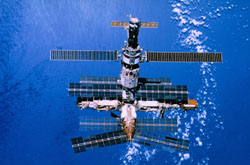Environmental protection from space
A collaboration of universities, industries and science laboratories, under the European Fourth Framework Program, has studied the application of space techniques to environmental monitoring for potential future space missions. The study has shown that a small size Fourier spectrometer for measurements in the thermal to far infrared (9-100 micrometers) will provide observations in a spectral region, that are not currently measured from space. The instrument named REFIR (Radiation Explorer in the Far Infrared) is suitable for vertical sounding of temperature and water vapour of the high troposphere. It will provide scientific information that will aid the understanding of the contribution of far infrared radiation, to the cooling of the atmosphere. It will also clarify the role of water vapour and that of clouds, in modulating the planetary radiation emission. The accrued knowledge will result in considerable improvement of current simulations on radiance, fluxes and cooling rates. The feasibility of the above relies on the technical ability of manufacturing a far infrared REFIR Fourier Transform Spectrometer (RFTS) as the primary spectrometer accompanied by an embedded imager operating in an infrared window for scene and cloud identification. There is also a total energy radiometer, a broadband channel operating from 0.3 to 100 micrometers and finally, an add on imager for multi-channel imagery. The overall mass of the instrument is 70 kg, its power consumption 82 W and can process 170 kbits per second. Satellite companies are able to undertake the design, manufacture, assembly and integration of the instrument on a satellite. The instrument is suitable for autonomous missions on small satellites in low earth orbits, or can be included in larger missions having a lifetime that exceeds 3 years. The foreseen impact on environmental sciences from the exploitation of REFIR will hopefully attract the interest of space agencies.



